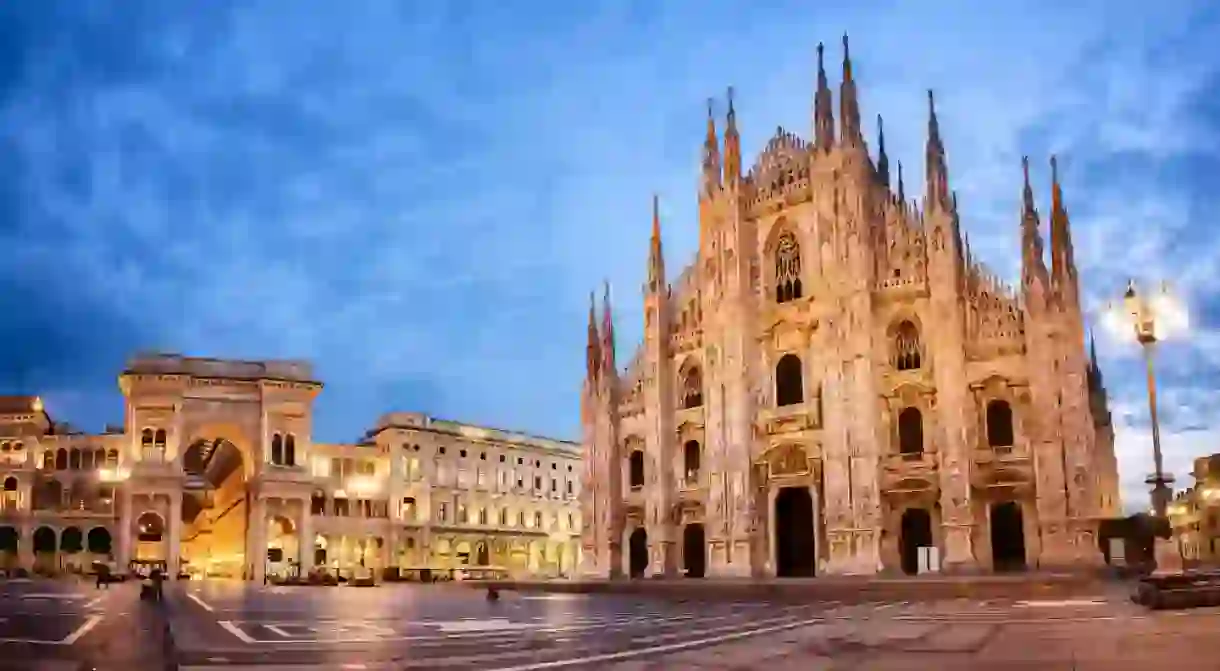10 Things You Never Knew About Milan's Cathedral

The majestic Duomo is to Milan what Notre-Dame is to Paris. It is an iconic symbol of the city and widely known as the biggest and arguably the most elaborate Gothic building in Italy. Geek up before you visit, with this list of facts.
It took six centuries to complete
Construction on the Duomo officially began in 1386, under instruction from Archbishop Antonio da Saluzzo and was not completed until 1900.
Over 78 lead architects were consulted for its development…
In 1387, Gian Galeazzo Visconti, Lord of Milan, set up the Veneranda Fabbrica del Duomo to supervise the design, building and conservation of the Cathedral. The design was created in compliance with elements of Lombard Gothic style, a delineation of Lombard Romanesque style, from which it inherited structural decisions and the traditional material, brickwork. But then Visconti made the decision to use Candoglia marble to construct the whole monument, which created a new challenge for the Italian Fabbrica. To continue with the realisation of the spectacular project, they had to employ architects, sculptors and stone-cutters from outside of Italy, who were expert in the Central European Gothic style. It is this turn of events that gave rise to the Duomo’s unique Gothic aesthetic.
…but the architect of the original design is unknown
Today the Veneranda Fabbrica del Duomo has a record of architects that contributed to the creation and restoration of the building between 1387 and 1988. And yet, they have not been able to trace the name of the architect who worked on the delicate initial phase of design.

It is home to the ‘protector’ of Milan
The Milano Madonnina is a four-metre high, golden statue of the Virgin Mary, a key symbol of the city and ‘protector’ of the Milanese. She was added before the façade was officially complete, raised as the highest statue on the structure, in December 1774. A law has since been passed stating that no new constructions can be higher than the revered statue. On the eve of World War II, in August 1939, a grey-green cloth was placed over the Madonnina to act as camouflage. She remained covered for five years, to avoid providing an easy target for bombers.
It houses the first baptistery in Christianity to have an octagonal construction
Or rather, it houses the foundations of the first Christian baptistry to have an octagonal construction, because the Fabbrica sold the columns and marbles. The Baptistery of San Giovanni alle Fonti was constructed circa 387. Together with the seven days of creation, the octagon is symbolic of the eighth day, that of eternity. It also commemorates the eight Evangelical Beatitudes.

It has the second-largest organ in Europe
The current iteration of the Cathedral’s organ was added in 1938. Housed within the structure’s majestic naves, it comprises five bodies and 15,800 pipes, the tallest of which measures over nine metres (29.5 feet), while the smallest measures only a few centimetres. This makes it the second-largest in Europe in terms of the number of pipes and registers, the first being the organ of Passau Cathedral, in Germany. It is a spectacle to behold and magnificent to listen to.
Johannes Bach has played here
While studying music in Berlin, the mighty Johannes Bach fell in love with the Italian style and soon arrived Milan, where he was awarded the position of second organist at the Duomo. He was appointed in 1760 and played for two years, before departing for England. During this time, he composed two Masses, a Requiem, and a Te Deum amongst other works.

You can stand on the roof
Unlike most other historic monuments in Italy, where you climb to a viewing tower, at the Duomo you climb to the actual roof. It offers panoramic views of the city and, on a clear day, you can see all the way to the snow-peaked Alps in the north. It is the best place in the city to watch the sunset, but if you prefer to see the twinkling lights of the metropolis there is also the possibility of a night tour.

The design is not all about Christianity
Amidst the Cathedral’s intricately sculpted patriarchs, prophets, martyrs and saints designed to convey a message of Christian salvation, a keen eye will spot the curious peducci. The peducci serve the architectural function of supporting the springer of the superior trefoil arch, but on the Duomo they also exist as sculptural objects in their own right. The small carvings started being added in the 15th century, to create a record of society at the time – the rituals, fears, ideals and non-religious beliefs of the people. In addition to historical figures from throughout the centuries, these small embellishments also depict laymen, fantastical creatures, fruits and flowers, heads and masks, and symbols to represent different vices and virtues. They are a fascinating register of how traditions and culture have evolved over time.













